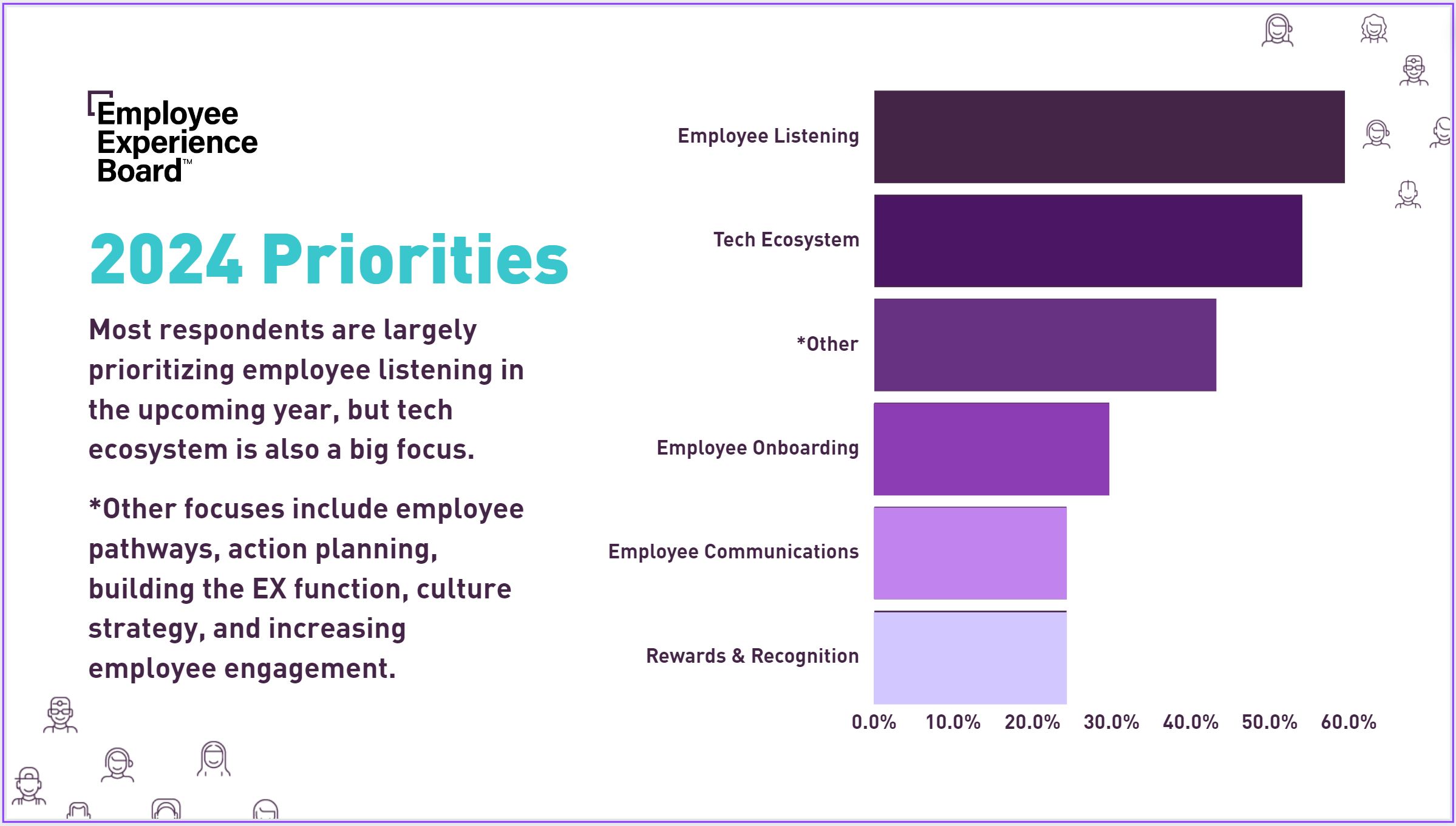Key takeaways:
- Implement global listening for holistic integration: Senior leaders stressed the vital role of active listening across global teams to embed EX initiatives into daily operations, advocating close partnerships with HR business partners to achieve effective integration.
- Overcome collaboration challenges: Our members highlighted the importance of fostering a collaborative culture across departments and leveraging expertise from various organizational corners to navigate disconnects.
- Unify business objectives with data-driven alignment: Leverage data-driven narratives to illustrate the impact of EX on cost savings and efficiency, urging for strategic alignment of EX goals with broader business objectives to secure more buy-in.
During a recent Employee Experience Board panel discussion, senior employee experience (EX) leaders provided insights on key strategies and challenges in forging a strong collaboration between EX and HR teams for standing up a successful EX program.
Our members shed light on the importance of global listening, connecting EX initiatives to all facets of your organization, and provided steps to address some of the challenges with the disconnect between HR and EX teams.
We explore the best practices shared to ensure your HR team is actively involved in enhancing the employee experience and how you can drive alignment across your company.
Strategic Global Partnership: Leveraging Employee Listening to Embed EX Initiatives Across All Business Units
Kate Zimberg, Senior Vice President of Human Resources at F5, stressed the importance of active listening across global teams to better understand the diverse levels of employees worldwide.
This sentiment was common amongst senior EX leaders. In the 2024 State of Enterprise Employee Experience Report, a majority of Employee Experience Board members reported that employee listening will be a top priority next year for their teams.

Top 2024 priorities according to Employee Experience Board Members in the 2024 State of Enterprise EX Report.
Kate noted that partnering closely with HR business partners for employee listening is vital to embed EX initiatives effectively into everyday operations.
“It is great to create an employee experience in all of our programs, systems, processes, centered on what the business needs, and that’s all incredibly important,” Kate said. “But so many of us rely on those HR business partners to get it embedded, and to make it a part of the everyday life of employees out in the field.”
Christopher Hawkins, Director of HRIS, Payroll, Data Governance, and Reporting at Grainger, emphasized the need to focus not just on siloed approaches but on understanding different experiences across various business units.
Connecting with team members from different operational sectors — sales, distribution centers, customer support — ensures a holistic view of employee experiences, which Christopher said is a crucial aspect often overlooked in centralized strategies.
“So many of us rely on those HR business partners to get it embedded, and to make it a part of the everyday life of employees out in the field.”
Kate Zimberg, F5
Navigating Cross-Functional Collaboration Challenges for Seamless Employee Experience Ownership
Nicole Sloane, HR Director of Global Employee Experience at Kimberly-Clark, highlighted inherent challenges stemming from cross-functional collaboration. She explained that the disconnect arises from multiple stakeholder engagement levels, budget allocations, and strategic thinking differences across departments.
To overcome this, Nicole said fostering a collaborative culture across departments and leveraging expertise from different organizational corners is imperative.
Experts in various organizational areas can serve as valuable resources once you establish these connections. Whether it’s technology-related matters or aspects like usability and user experience, these skills might reside in IT or even within marketing for a customer-centric perspective.
Nicole shared that leveraging these cross-departmental partnerships allows you to access more skills and expertise that may not be directly within your team.
Kate further expanded on potential disconnects, indicating scenarios where groups may not perceive their role in employee experience or claim exclusive ownership.
To address this, cultivating a collective ownership mindset is vital.
“Bringing those individuals together is critical so that they can understand they all own pieces of it, because this is a really big body of work and focus,” said Kate. “Helping them see it’s not a single owner; sometimes if you don’t have a direct EX team, it’s not a single owner. It’s multi-ownership.”
Driving Resource Allocation and Accountability for EX Goals
Christopher reiterated the importance of data-driven narratives to illustrate the impact of employee experience on cost savings, efficiency improvements, and reduced turnover. He shared that this approach establishes a unified support by objectively showcasing the tangible benefits of an effective EX program.
“If I can show the ‘why’ behind it, and how we’re saving costs or saving time, then everybody’s going to agree,” Christopher said. “Then it makes it very easy to prioritize, regardless of what department it’s coming from.”
Nicole emphasized strategic alignment and shared objectives as essential pillars for ease of collaboration.
“If I can show the ‘why’ behind it, and how we’re saving costs or saving time, then everybody’s going to agree.”
Christopher Hawkins, Grainger
Aligning your EX goals with broader business objectives not only secures leadership buy-in but also supports organizational culture, a pivotal selling point for both employees and candidates.
“If you can get aligned on what objectives you’re all collectively working toward, then I think things become a little easier because you have common objectives,” Nicole said. “And different teams have different parts that are leading toward that objective. But align on that and your guiding principles. I think as people have more and more alignment, then that conversation becomes easier.”
Kate echoed the sentiment, advocating for aligning employee experience with your overall company culture to ensure a consistent narrative across all touchpoints, fostering a deeply ingrained organizational ethos.
“If you can get aligned on what objectives you’re all collectively working toward, then I think things become a little easier because you have common objectives.”
Nicole Sloane, Kimberly-Clark
Learn How Leading EX Leaders are Establishing Effective Partnerships with HR Teams
Ultimately, successful collaboration between EX and HR teams hinges on active communication, shared objectives, and a holistic view of employee experiences.
If you lead employee experience at a billion-dollar company, gain more insights in the Employee Experience Board on how to forge an effective partnership with HR to create a unified, seamless employee journey that aligns with business goals and reflects your company’s culture.
Our members are all senior EX leaders and meet weekly to benchmark their top priorities and share actionable insights to enhance their initiatives.


